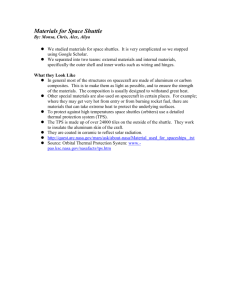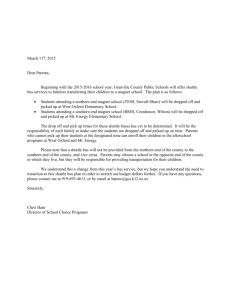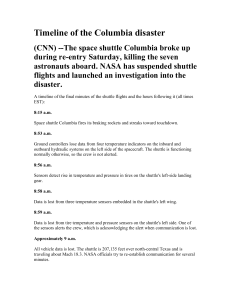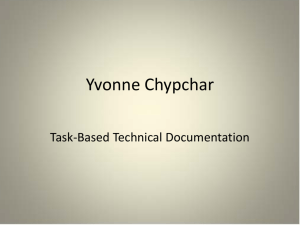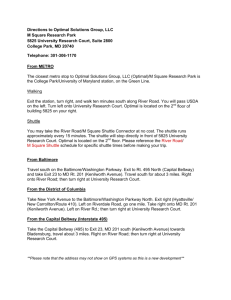Paper 4 (final draft)
advertisement
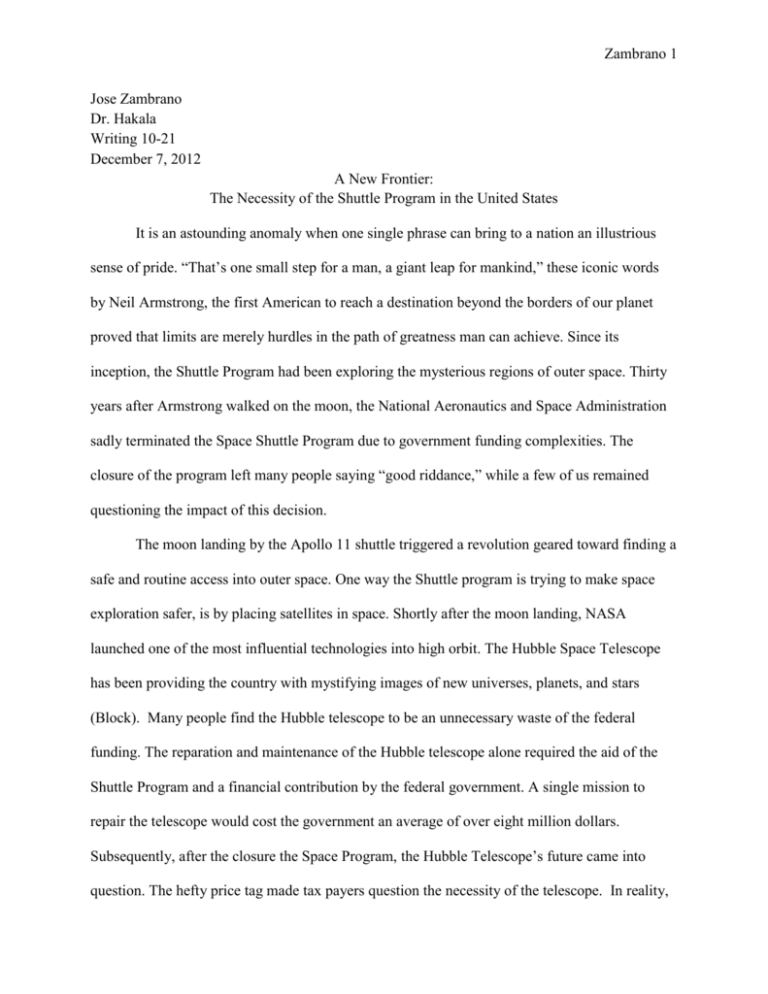
Zambrano 1 Jose Zambrano Dr. Hakala Writing 10-21 December 7, 2012 A New Frontier: The Necessity of the Shuttle Program in the United States It is an astounding anomaly when one single phrase can bring to a nation an illustrious sense of pride. “That’s one small step for a man, a giant leap for mankind,” these iconic words by Neil Armstrong, the first American to reach a destination beyond the borders of our planet proved that limits are merely hurdles in the path of greatness man can achieve. Since its inception, the Shuttle Program had been exploring the mysterious regions of outer space. Thirty years after Armstrong walked on the moon, the National Aeronautics and Space Administration sadly terminated the Space Shuttle Program due to government funding complexities. The closure of the program left many people saying “good riddance,” while a few of us remained questioning the impact of this decision. The moon landing by the Apollo 11 shuttle triggered a revolution geared toward finding a safe and routine access into outer space. One way the Shuttle program is trying to make space exploration safer, is by placing satellites in space. Shortly after the moon landing, NASA launched one of the most influential technologies into high orbit. The Hubble Space Telescope has been providing the country with mystifying images of new universes, planets, and stars (Block). Many people find the Hubble telescope to be an unnecessary waste of the federal funding. The reparation and maintenance of the Hubble telescope alone required the aid of the Shuttle Program and a financial contribution by the federal government. A single mission to repair the telescope would cost the government an average of over eight million dollars. Subsequently, after the closure the Space Program, the Hubble Telescope’s future came into question. The hefty price tag made tax payers question the necessity of the telescope. In reality, Zambrano 2 the technology used in creating and operating the telescope helped formulate the Digital Imaging Breast Biopsy System. The Breast Biopsy System led to the early detection of breast cancer, which would have never been discovered without the aid of the Shuttle Program (Block). Along with technological developments, the shuttle program stumbled upon several medical advances. Most of the technology used in surgery originates from the technology employed in space. In cataracts surgery, the tools needed to perform the procedure were originally developed by NASA to execute routine satellite maintenance. The Light-emitting diodes that detect signals from satellites were later adapted by the medical field, to help surgeons perform procedures on patients that had brain cancer. These developments prove the impact the Shuttle Program continues to have on our daily lives. Scientists are slowly uncovering new innovations, which would be further enhanced with the aid of the Shuttle Program. Therefore I believe the Shuttle program should be reestablished. As a nation we need to expand our knowledge by exploring the mystifying regions beyond Earth. Calamities such as the Colombia and Challenger missions should not influence our perspectives of the shuttle program, but instead have us pondering the purpose behind conducting these missions. On February 1, 2003, the launch of the shuttle Colombia resulted in the death of seven astronauts (Carol). The shuttle exploded upon entering the atmosphere due to a damaged piece of insulation. The accident cost the nation a staggering amount of six million dollars. After a thorough investigation by the government, the National Aeronautics and Space Administration vowed to employ several new techniques and programs that would ensure the safety of their crew members. In hopes of regaining the American people’s confidence and support, NASA introduced the program Independent Verification and Validation, also known as IV and V, to the next Zambrano 3 generation of shuttles. IV and V is highly advanced computer software that makes it possible to achieve an economically priced and safe space mission. Its main purpose is to eliminate any error that may pose a threat to the mission. Unlike most common programs, the IV and V software is divided into several smaller systems. Each system inspects a single aspect of the mission which in turn eliminates any oversights. The early detection rate and on board navigation eliminated around 3.5 million dollars from the cost of each operation (Zelkowitz). Though the program was successful in decreasing the amount of fatalities and cost, it was not able to spare the program from budget cuts. As the shuttle program loomed its termination, the government gave the National Aeronautics and Space Administration two options. Unhappy with the outcomes of the program, the government demanded that NASA create a newly redesigned shuttle that had the capability of surpassing the distance beyond the moon, and complied with environmental regulations. If NASA did not comply, the Shuttle Program would be disbanded. The chemical discharge by the shuttles had eco-activists calling for their retirement. The auxiliary power units required the use of the inorganic compound hydrazine (Schelmetic). When hydrazine comes into contact with the human skin, it can cause irritation and in sever circumstances can cause kidney, liver, and cell damage. Since hydrazine is a cost-effective and simple compound to manufacture, the need for another power source seemed unnecessary. The gradual pace at which the technology was developing along with the budget set by the government, made it seemingly impossible to attain such a goal of an environmentally clean space shuttle. As a result, the landing of the shuttle Discovery marked the end of the space exploration era. Most people assume the shuttle program’s main priority is sending astronauts to unexplored destinations. What they fail to realize is that NASA was established on the condition Zambrano 4 that the foundation will protect the people of Earth, from any dangers that may originate from space. (Wall). Asteroids, comets, and solar radiation pose a grave threat to our delicate environment. Years before the shuttle program was abolished, NASA commenced a special task force aimed toward resolving these menacing situations. In preparation for the unforeseeable future, they contemplated conducting one of the most treacherous missions ever performed in history. In the worst-case scenario, NASA aspired to send astronauts onto the surface of a moving asteroid. The plan was too obliterate the space rock by deploying a nuclear bomb before the asteroid could impact the planet. The question that seemed to be on everyone’s mind was whether the project was pure brilliance or stupidity on NASA’s behalf. The associated press called this “audacious stunt, a desperate attempt to save NASA’s beloved space program” (Wall). What the press failed to comprehend is the necessity of such an “audacious” stunt. On October 12th, 2012, the asteroid TC4 merely avoided the Earth’s atmosphere. The size as well as the speed, at which the space rock was traveling, would have annihilated almost all species on the planet (Atkinson). After the closure of the Shuttle Program, the United States government bestowed the rights of the International Space Station to Russia; with the condition that Russia will allow American astronauts to assist in their space missions (Atkinson). The relations between the United States and the Soviet Union, now called Russia, have never fully recovered since the Cold War conflict. As a result, the hostility between these two countries will make it hard to agree upon a solution, especially during hectic situations. Therefore, the government’s plan to coincide with the Russian’s Space Program will not result in a prosperous outcome for neither countries. Zambrano 5 By abandoning the space program the country will be abdicating the development of technology. Most modern technologies we use today like laptops, cell phones, and GPS, were originally developed for space missions. Global Positioning Systems are still under the jurisdiction of the National Aeronautics and Space Administration’s satellites (Block). By investing in the shuttle program, not only will we be investing in the production of new technology, but we will also be rejoicing in the creation of new jobs. The termination of the shuttle program ended up costing Florida over nine-thousand jobs, most of which were privately owned small businesses (Rein). Rob Summers was the owner of a T-shirt printing shop in Titusville, Florida. The recent closure of Cape Canaveral made it impossible to attract any new customers to his printing shop. As a result, shortly after the closure of the program, he allowed the bank to foreclose on his business. He argues that "For every job lost on the space side, we'll lose two jobs in the city, so it's a big ripple effect" (Rein). With over six hundred million dollars in revenue lost per year, the closure of the program proved to not only cost the United States money, but also cost Americans a steady income. The “ripple effect” expanded beyond the surrounding areas of Cape Canaveral. Here in California alone, several plants that manufactured the parts for the shuttles suffered massive layoffs. In the city of Downey California, the plant Boeing closed its doors taking away over twelve-thousand present jobs, and over fifty-thousand future jobs (Suciu). The company paid an excellent wage for recent college graduates, most of which attended Ivy-league schools. The average worker in the Boeing plant had been working for the company longer than fifteen years (Anton). The termination of the shuttle program spelled an end to their once prosperous careers. Many of the engineers working on the shuttles had to find work in an area beyond their expertise to be able to pay off their school loans. Bill Roberts entered the company after completing his Zambrano 6 college education in 1982. The closure of the Boeing plant forced Bill to return to his old alma mater, in hopes of attaining a new career with a new major (Anton). The government needs to take into consideration the prosperity of their people, and not just the fiscal aspects of the country. Both the ex-president George W. Bush and current president Barack Obama, agree that the shuttle program will bring a prosperous outcome for the future of space exploration and the country. In one of his addresses to congress, George W. Bush listed the overall goals for the space program; which included listing possible contributors that will aid in the financing of the program. Companies like Virgin and Armadillo Aerospace are willing to work with NASA and the government, to supply the space crafts (Bush). The shuttles contemplated by the private spaceflight companies comply with the requirements set by the government. By allowing these private sectors to bestow the shuttles, the government will be spared 450 million dollars per mission. (Carol). Providing a cost efficient mission into space can become a reality. As shown countless of times before, the shuttle program will incite technological as well as medical breakthroughs that result in our survival. Because the shuttle program is government mandated and requires its consent to function, it is up to federal representatives to decide upon the future of the program. It is understandable to be hesitant on accepting the Shuttle Program, when the cost of the program ranges from five to four-hundred million dollars per mission, but by cutting some unnecessary government spending, the Shuttle Program can be successfully restored. One of the biggest wastes of taxpayer’s money is the maintenance of vacant buildings. Each year the government spends an average of 25 billion dollars on maintaining unused properties (Reybern). By cutting this unnecessary expenditure, it is possible to perform one or two space exploration missions per year. The Shuttle Zambrano 7 Program has been conducting more than just voyages into unexplored destinations. Here at home, the program provided Americans with prosperous jobs and a financially stable economy. Therefore, abandoning the Shuttle Program is not the best solution to resolve the countries fiscal deficit. I urge federal representatives to lend their voices to reinstating this vital program. By reinstating the Shuttle Program, I assure you that Americans will regain their pride and confidence in NASA. Zambrano 8 Works Cited: Anton, Mike. "Charting Space Shuttle History on the Southland Map." Los Angeles Times 08 Oct. 2012: n. pag. Print. Atkinson, Nancy. "Asteroid 2012 TC4 to Buzz Earth on October 12." Universe Today. N.p., 11 Oct. 2012. Web. 27 Nov. 2012. <http://www.universetoday.com/97927/asteroid-2012tc4-to-buzz-earth- on-october-12/>. Block, Melissa. "Shuttle Program Helped Advance Technology." National Public Radio. N.p., 28 Apr. v 2011. Web. 27 Nov. 2012.<http://www.npr.org/2011/04/28/135812694/shuttleprogram-helped-advance-technology>. Bush, George W. "President Bush Delivers Remarks On U.S. Space Policy." NASA Facts. N.p., 14 Jan. 2004. Web. 28 Nov. 2012<http://www.nasa.gov/pdf/54868main_bush_trans.pdf>. Carol, Chris. "Shuttle Program Brought Breakthroughs, but Proved Costly and Dangerous." Stars and Stripes 5 July 2011: n. pag. Web. http://www.stripes.com/shuttle-program-broughtbreakthroughs-but-proved-costly-and-dangerous-1.148418 Charles, Michael T. "The last flight of space shuttle Challenger." Coping with Crises, Charles C. Thomas, Springfield, IL (1989): 141-168. Kitts, Christopher, et al. "Emerald: a low-cost spacecraft mission for validating formation flying technologies." Aerospace Conference, 1999. Proceedings. 1999 IEEE. Vol. 2. IEEE, 1999. Rein, Lisa. "Shuttle Program’s End Means Lost Jobs." The Washington Post. ProQuest, 11 July 2011. Web. 27 Nov. 2012. <http://www.washingtonpost.com/blogs/federaleye/post/shuttle-programs-end-means-lost-jobs/2011/03/23/gIQAQMbQSI_blog.html>. Zambrano 9 Reybern, Stan. "12 Outrageous Wastes of Taxpayers’ Money." Bill Shrink. N.p., 24 Sept. 2009. Web. 02 Dec. 2012. <http://www.billshrink.com/blog/5626/government-wastes/>. Schelmetic, Tracey. "The Eco Pros and Cons of the Space Shuttle Program." ThomasNet. N.p., 19 July 2011.Web.02Dec.2012.<http://news.thomasnet.com/green_clean/2011/07/19/theeco-pros- and-cons-of-the-space-shuttle-program/>. Streich, Michael. "Is the End of the Space Shuttle Program More than Mere Symbolism?" Suite101. N.p., 21 July 2011. Web. 27 Nov. 2012. <http://suite101.com/article/is-the-endof-the-space-shuttle-program-more-than-mere-symbolism-a380857>. Suciu, Peter. "End of Space Shuttle Program To Have Far Reaching Impact." CNBC. N.p., 8 July 2011.Web.27Nov.2012.<http://www.cnbc.com/id/43469916/End_of_Space_Shuttle_Pro gram_To_Have_Far_Reaching_Impact>. Wall, Mike. "NASA's Shuttle Program Cost $209 Billion — Was It Worth It?" Space.com. N.p., 5 July 2011. Web. 12 Nov. 2012. <http://www.space.com/12166-space-shuttle-programcost-promises-209-billion.html>. Zelkowitz, Marvin V., and Ioana Rus. "Understanding IV & V in a safety critical and complex evolutionary environment: the NASA space shuttle program." Proceedings of the 23rd International Conference on Software Engineering. IEEE Computer Society, 2001.
